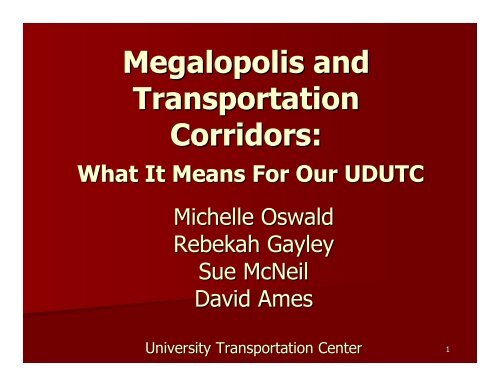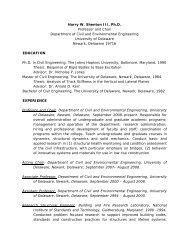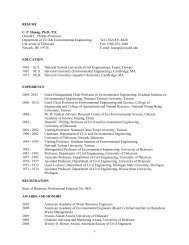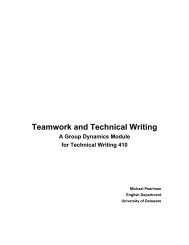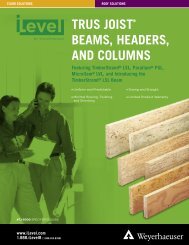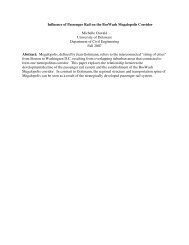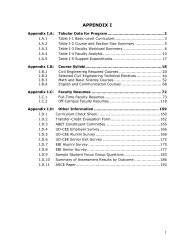Megalopolis and Transportation Corridors: What it Means for our ...
Megalopolis and Transportation Corridors: What it Means for our ...
Megalopolis and Transportation Corridors: What it Means for our ...
Create successful ePaper yourself
Turn your PDF publications into a flip-book with our unique Google optimized e-Paper software.
<strong>Megalopolis</strong> <strong>and</strong><strong>Transportation</strong><strong>Corridors</strong>:<strong>What</strong> It <strong>Means</strong> For Our UDUTCMichelle OswaldRebekah GayleySue McNeilDavid AmesUnivers<strong>it</strong>y <strong>Transportation</strong> Center1
Overview Purpose Research Questions <strong>Transportation</strong> Planning <strong>for</strong> mega-regions– Northeast transportation corridor Background on <strong>Megalopolis</strong> Significance of <strong>Megalopolis</strong> Defin<strong>it</strong>ion of Resiliency Resiliency Measurements Mapping Resiliency of <strong>Megalopolis</strong><strong>Transportation</strong> Networks from 1890-2006 Future Tasks2
Purpose UTC’s s focus: resiliency of transportation corridors Project goal: to underst<strong>and</strong> the currenttransportation characteristics of the BosWashcorridor <strong>and</strong> to research <strong>it</strong>s resiliency <strong>and</strong>responsiveness to external changes. Final result: to build a strategic database <strong>for</strong>future research <strong>and</strong> identify the key factors inresiliency analysis <strong>and</strong> modeling <strong>for</strong> transportationcorridors.3
<strong>Transportation</strong> Planning <strong>for</strong>mega-regions Dilemma- how to effectively managemega-regions from a transportationnetwork perspective? Results of failure due to lack ofcollaboration:– Traffic Congestion– Environmental Degradation– Structural Impairment– Social Injustices due to Lim<strong>it</strong>ed Mobil<strong>it</strong>y5
<strong>Transportation</strong> Impacts Rail companies <strong>for</strong>med the in<strong>it</strong>ial “spine”of the Northeast corridor Highway networks <strong>for</strong>med the “skeleton”of the corridor Urban sprawl led to overlapping suburbanareas6
Northeastern CorridorCommutersheds(Miller, 1975)7
Duration of Northeastern CorridorCommutes(Regional Plan Association, 2007)8
Socioeconomic Clustering w<strong>it</strong>hinthe Northeastern Corridor(Short, 2006)9
Background on Mega-regions Jean Gottmann (1961)– <strong>Megalopolis</strong>: “large c<strong>it</strong>y”– Based on overlappingsuburban clusters– “string of c<strong>it</strong>ies”– 455 miles(Short, 2007)10
<strong>Megalopolis</strong>: No longer unique Researchersextend<strong>Megalopolis</strong>thinking to otherregions of thecountry.– 10 Megapol<strong>it</strong>anareas will grow to20 in the next twodecades(Dhavale <strong>and</strong> Lang, 2005)11
Background on Mega-regions Regional PlanAssoc. 1967Report– Atlantic UrbanRegion– “New fact of life <strong>for</strong>planners <strong>and</strong> policymakers” Richard Morrill– Update toGottmann’s s mapson population growth Robert Lang– Presently 10regions in US– 20 regions in 2040(Morrill, 2006)12
US Census Statistical Designations Metropol<strong>it</strong>an statistical area (MetroSA’s) Micropol<strong>it</strong>an statistical area (MicroSA’s) Combined Statistical Area (CSA) Megapol<strong>it</strong>an Region:– At least two, contiguous CSA’s– “Organic” cultural region - distinct history <strong>and</strong> ident<strong>it</strong>y.– Similar physical environment.– Linkages through major transportation infrastructure.– Functional urban network via goods <strong>and</strong> service flows.– Usable geography that is su<strong>it</strong>able <strong>for</strong> large-scale regional planning.13
Combined Statistical Areas(US Census, 2004)14
National Megapol<strong>it</strong>an Regions(Dhavale <strong>and</strong> Lang, 2005)15
Significance of Mega-regions Interconnectiv<strong>it</strong>y between metropol<strong>it</strong>an areas(Dhavale <strong>and</strong> Lang, 2005)16
Background on Megapol<strong>it</strong>ans Projected National Growth vs. ProjectedMegapol<strong>it</strong>an Growth(Dhavale <strong>and</strong> Lang, 2005)17
Background on Mega-regions:Northeast Corridor Historical Population Change from1950 to 2000(Dhavale <strong>and</strong> Lang, 2005)18
Defin<strong>it</strong>ion of Resiliency <strong>What</strong> is resiliency?? Adaptabil<strong>it</strong>y of a system to adjust under stress Responsiveness to internal <strong>and</strong> external changes Measure of persistence <strong>and</strong> sustainabil<strong>it</strong>y of systems <strong>and</strong>relationships between– L<strong>and</strong> use– Environmental changes– Unexpected events– <strong>Transportation</strong>Short <strong>and</strong> LongTermDisturbancesSYSTEMADAPTRESPONDRECOVER19
Resiliency Measurements Traffic oriented measurements– Episodic Traffic accidents Construction Weather– Continual Traffic congestion Travel time reliabil<strong>it</strong>y Route redundancy Irreversibil<strong>it</strong>y Connectiv<strong>it</strong>y Continu<strong>it</strong>y20
Mapping Resiliency of<strong>Transportation</strong> Networks– F<strong>our</strong> Time Periods Pre 1900 1920 1947 2006– Analysis of resiliency Urbanized growth- increased population throughout corridor Redundancy in routes- line dens<strong>it</strong>y– 3 Steps: Population Dens<strong>it</strong>y Network Dens<strong>it</strong>y (railway <strong>and</strong> highway) Comparison between population <strong>and</strong> network21
Population Growth1890RAILWAYNETWORK2006HIGHWAYNETWORK22
Rail Line Dens<strong>it</strong>y1890200623
Highway Dens<strong>it</strong>y1920200624
Comparison1890200625
Future Tasks Complete the Discussion Paper: Background ofthe BosWash <strong>Megalopolis</strong> Corridor Research the topic of “resiliency” <strong>and</strong> how <strong>it</strong>relates to the <strong>Megalopolis</strong> corridor Focus on l<strong>and</strong> use changes w<strong>it</strong>hin the corridor Evaluate future projections (+2040) inpopulation, employment, <strong>and</strong> affects ontransportation <strong>for</strong> the corridor26
References DeCerreno, Alison L. C. (2007) The Future of <strong>Transportation</strong> in the NortheastCorridor, 2007-2025: 2025: Rail <strong>Transportation</strong>. . New York: NYU Wagner Rudin Center. Dhavale, Dawn <strong>and</strong> Robert E. Lang. (2005). Beyond <strong>Megalopolis</strong>: Exploring America’sNew “Megapol<strong>it</strong>an” Geography. Metropol<strong>it</strong>an Inst<strong>it</strong>ute at Virginia Tech Census Report05:01. Gottmann, Jean. (1961) <strong>Megalopolis</strong>: the Urbanized Northeastern Seaboard of theUS. Cambridge: MIT P. Houk, R<strong>and</strong>y. (2006). Railroad History. Retrieved on November 4, 2007 fromhttp://www.sdrm.org/history/timeline/. Lang, Robert E. <strong>and</strong> Arthur C. Nelson. (2007) Beyond the Metroplex: Examining Commuter Patterns at the “Megapol<strong>it</strong>an” Scale. . Lincoln Inst<strong>it</strong>ute of L<strong>and</strong> Policy. Morrill Richard. (2006). "Classic map revis<strong>it</strong>ed: The growth of <strong>Megalopolis</strong>."MProfessional Geographer. . 58.2 155-160.160. Regional Plan Association. Northeast Megaregion: 2050. Retrieved ed on December 15,2007 from http://www.rpa.org/pdf/NortheastReport.sm.pf Short, John Rennie, Bernadette Hanlon <strong>and</strong> Thomas J. Vincino. (2007)07) <strong>Megalopolis</strong> 50Years On: The Trans<strong>for</strong>mation of a C<strong>it</strong>y Region. International J<strong>our</strong>nal of Urban <strong>and</strong>Regional Research 31.2 344-367.367.27
Questions?? How does the concept of Mega-regions as aunique urban <strong>for</strong>m stimulate new perspectiveswhen viewing y<strong>our</strong> own research, especiallywhen pertaining to the BosWash Corridor? In real<strong>it</strong>y, what is the potential of mega-regionplanning to reorganize governance structures,private-sector involvement, <strong>and</strong>/or grass-rootsrootsaction in the future? How does one define <strong>and</strong> measure resiliency ina way that has meaningful implementation <strong>for</strong>researchers?28


